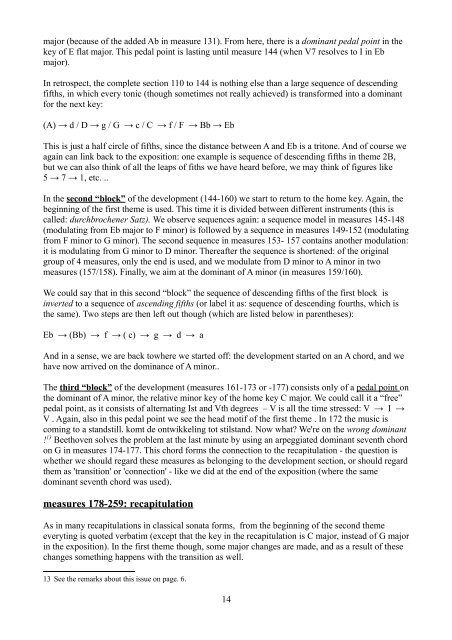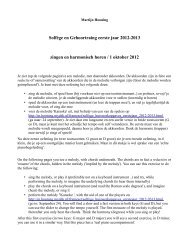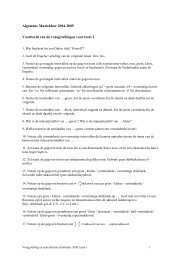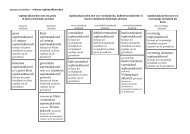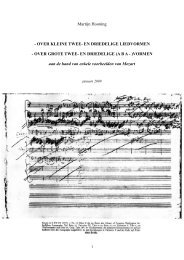Martijn Hooning SOME REMARKS ON SONATA FORM with an ...
Martijn Hooning SOME REMARKS ON SONATA FORM with an ...
Martijn Hooning SOME REMARKS ON SONATA FORM with an ...
Create successful ePaper yourself
Turn your PDF publications into a flip-book with our unique Google optimized e-Paper software.
major (because of the added Ab in measure 131). From here, there is a domin<strong>an</strong>t pedal point in the<br />
key of E flat major. This pedal point is lasting until measure 144 (when V7 resolves to I in Eb<br />
major).<br />
In retrospect, the complete section 110 to 144 is nothing else th<strong>an</strong> a large sequence of descending<br />
fifths, in which every tonic (though sometimes not really achieved) is tr<strong>an</strong>sformed into a domin<strong>an</strong>t<br />
for the next key:<br />
(A) → d / D → g / G → c / C → f / F → Bb → Eb<br />
This is just a half circle of fifths, since the dist<strong>an</strong>ce between A <strong>an</strong>d Eb is a tritone. And of course we<br />
again c<strong>an</strong> link back to the exposition: one example is sequence of descending fifths in theme 2B,<br />
but we c<strong>an</strong> also think of all the leaps of fiths we have heard before, we may think of figures like<br />
5 → 7 → 1, etc. ..<br />
In the second “block” of the development (144-160) we start to return to the home key. Again, the<br />
beginning of the first theme is used. This time it is divided between different instruments (this is<br />
called: durchbrochener Satz). We observe sequences again: a sequence model in measures 145-148<br />
(modulating from Eb major to F minor) is followed by a sequence in measures 149-152 (modulating<br />
from F minor to G minor). The second sequence in measures 153- 157 contains <strong>an</strong>other modulation:<br />
it is modulating from G minor to D minor. Thereafter the sequence is shortened: of the original<br />
group of 4 measures, only the end is used, <strong>an</strong>d we modulate from D minor to A minor in two<br />
measures (157/158). Finally, we aim at the domin<strong>an</strong>t of A minor (in measures 159/160).<br />
We could say that in this second “block” the sequence of descending fifths of the first block is<br />
inverted to a sequence of ascending fifths (or label it as: sequence of descending fourths, which is<br />
the same). Two steps are then left out though (which are listed below in parentheses):<br />
Eb → (Bb) → f → ( c) → g → d → a<br />
And in a sense, we are back towhere we started off: the development started on <strong>an</strong> A chord, <strong>an</strong>d we<br />
have now arrived on the domin<strong>an</strong>ce of A minor..<br />
The third “block” of the development (measures 161-173 or -177) consists only of a pedal point on<br />
the domin<strong>an</strong>t of A minor, the relative minor key of the home key C major. We could call it a “free”<br />
pedal point, as it consists of alternating Ist <strong>an</strong>d Vth degrees – V is all the time stressed: V → I →<br />
V . Again, also in this pedal point we see the head motif of the first theme . In 172 the music is<br />
coming to a st<strong>an</strong>dstill. komt de ontwikkeling tot stilst<strong>an</strong>d. Now what? We're on the wrong domin<strong>an</strong>t<br />
! 13 Beethoven solves the problem at the last minute by using <strong>an</strong> arpeggiated domin<strong>an</strong>t seventh chord<br />
on G in measures 174-177. This chord forms the connection to the recapitulation - the question is<br />
whether we should regard these measures as belonging to the development section, or should regard<br />
them as 'tr<strong>an</strong>sition' or 'connection' - like we did at the end of the exposition (where the same<br />
domin<strong>an</strong>t seventh chord was used).<br />
measures 178-259: recapitulation<br />
As in m<strong>an</strong>y recapitulations in classical sonata forms, from the beginning of the second theme<br />
everyting is quoted verbatim (except that the key in the recapitulation is C major, instead of G major<br />
in the exposition). In the first theme though, some major ch<strong>an</strong>ges are made, <strong>an</strong>d as a result of these<br />
ch<strong>an</strong>ges something happens <strong>with</strong> the tr<strong>an</strong>sition as well.<br />
13 See the remarks about this issue on page. 6.<br />
14


